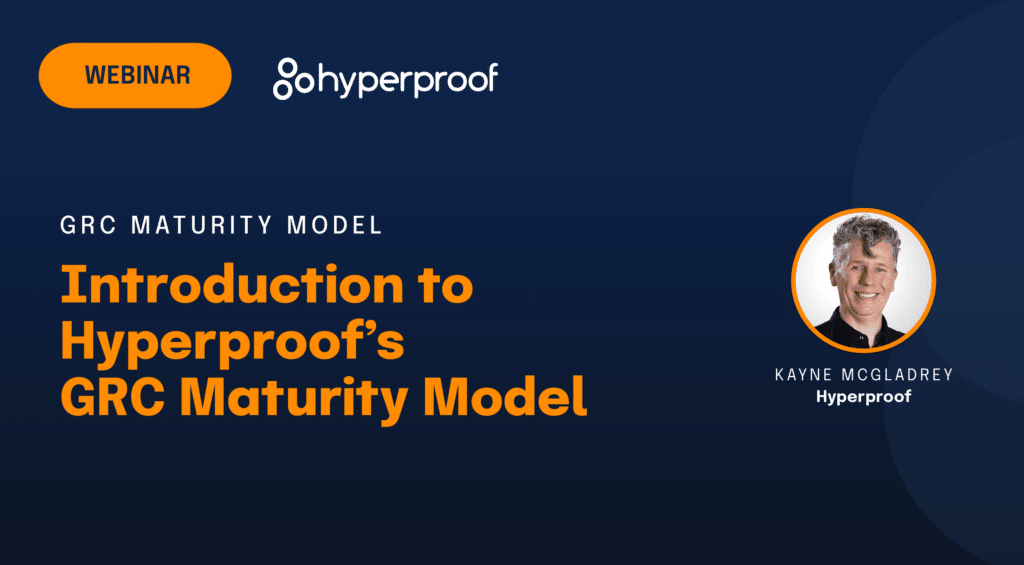A Crash Course on Hyperproof’s GRC Maturity Model

Something has been missing in the governance, risk, and compliance (GRC) space: the ability to truly understand an organization’s GRC maturity and the steps it would take to build the business case for change. As a CISO, I was surprised to find that there was no published, widely adopted maturity model for Governance, Risk, and Compliance (GRC).
Companies with mature GRC programs have an advantage over their competitors. However, that advantage may only be from hiring the right person at the right time, and not a deliberate effort to realize the business benefits of a well-run GRC program. Unfortunately, this leads to a GRC poverty line, where companies that cannot afford to hire the right people (or management consultants) struggle with a world of evolving regulatory and legal requirements. In today’s litigious environment, a mature GRC program can help shield companies, CISOs, and other senior executives from legal risks.
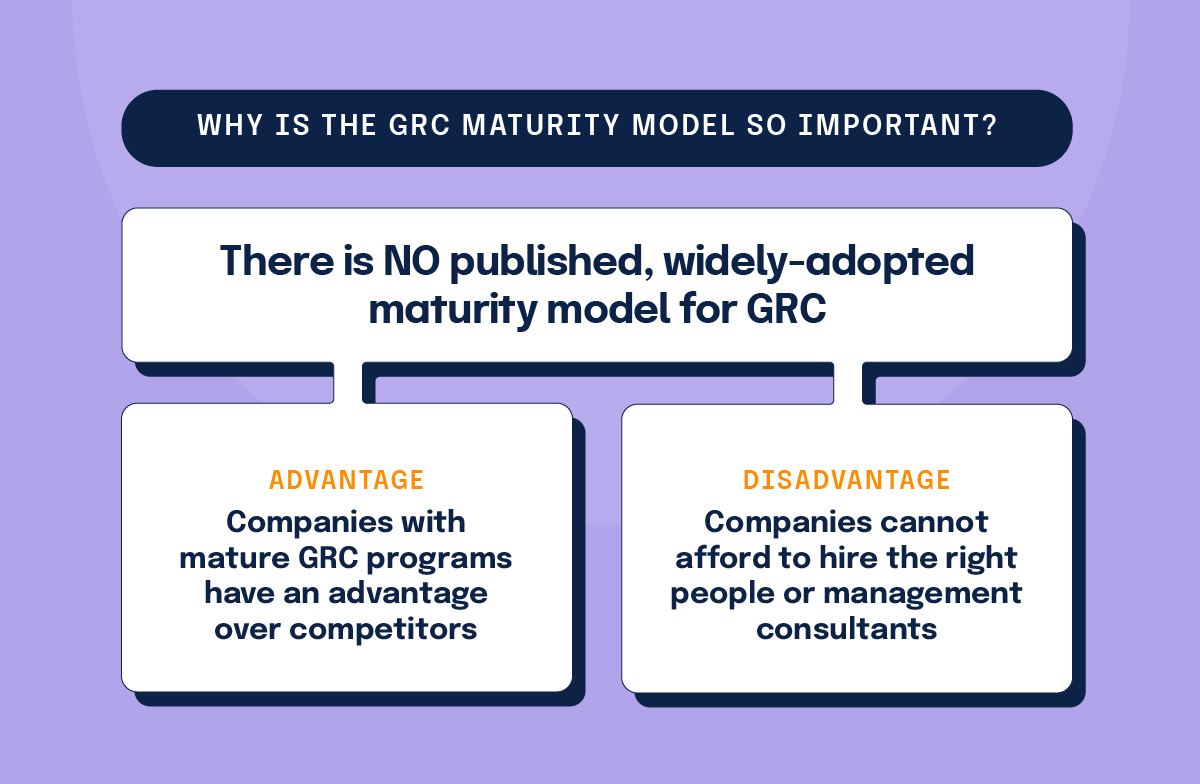
Maturity models are relatively commonplace in cybersecurity and provide a vendor-agnostic roadmap for how companies can improve key business operations. They’re an attempt to reduce community knowledge to paper so that organizations aren’t entirely dependent on hiring the “right” people to improve their cybersecurity.
For example, if you’re from a cybersecurity background, you might remember CISA’s Zero Trust Maturity Model. They didn’t just say, “Get better at Zero Trust.” CISA had to define what Zero Trust was, and what “good” looks like. Maturity models also differ from frameworks because they do not define hard requirements and are open to interpretation. Though a well-intentioned auditor may offer a different perspective on the finality of a maturity model, a well-written one should be used as a roadmap, not a recipe.
Want to see Hyperproof’s GRC Maturity Model in action?
In 2023, I created an in-depth, actionable GRC Maturity Model to level the playing field for all organizations. GRC helps organizations operate more efficiently and ethically, manage risks effectively, and comply with necessary laws and regulations, all of which are essential for long-term business success. By integrating governance, risk management, and compliance, organizations can align their strategic goals more closely with their operational and tactical activities. This model is a roadmap to help guide organizations on their path to maturity.
Sounds extensive, right? This post will review the GRC Maturity Model at a high level so you can get familiar with the structure and leverage it in the most practical and efficient way possible.
What is the GRC Maturity Model?
Hyperproof’s GRC Maturity Model is an attempt to create an accessible roadmap for organizations of all sizes. It’s a commonly accepted way for companies to assess and improve their own GRC capabilities, with a vendor-agnostic view of business processes and characteristics that define GRC.
The model is segmented into four levels:
1. Traditional
Reactive with insufficient or no planning
2. Initial
Beginning to define processes at a departmental level
3. Advanced
Establishing defined, repeatable processes at the organizational level
4. Optimal
Proactively using measurements to continuously improve performance
Each maturity level represents intentional work on the part of an organization to improve, though once that work has been completed, it should be considerably easier to sustain.
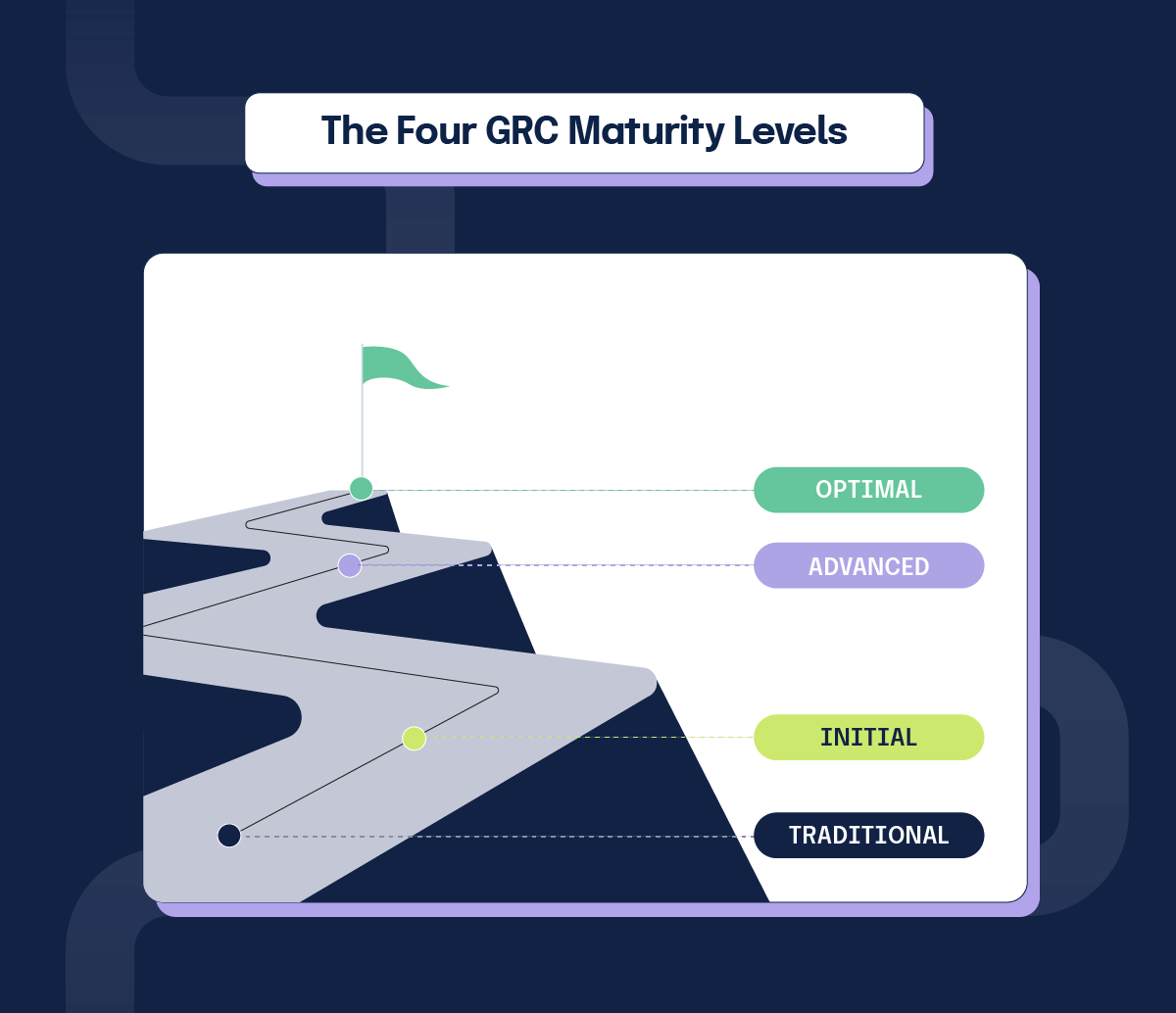
Each level is defined by unique characteristics to help readers identify where their company might be on the path. The model is a vendor-neutral self-scored journey for organizations to get better at doing something important. It serves as a roadmap, guiding organizations to take intentional steps to reach higher levels of maturity.
How do I use the GRC Maturity Model?
The GRC Maturity Model is segmented into four domains:
Within each section, you’ll get:
- An overview of each domain’s definition
- An overview of activities (i.e. the most common business processes associated with the domain
- A simplified maturity chart listing the attributes associated with each maturity level
To make the GRC Maturity Model as useful as possible, we have also included in-depth characteristics of the business processes in each domain, including:
Either the chart or the characteristics can be used to determine the relative maturity level of an organization. In cases where an organization has observable characteristics from across maturity levels (such as exhibiting both Traditional and Initial behaviors), it is up to the judgment of the reader how to decide which maturity level the organization has reached. Each level assumes that the characteristics of the prior or lower level have been achieved.
Governance
According to the model, Governance is a set of six processes:
- Board oversight and direction
- Ethical and sustainable practices
- Financial oversight and management
- Information and technology governance
- Mission, vision, and values
- Policies and procedures
Each of those processes can be at a different maturity level, from Traditional to Optimal. Here’s an example of board oversight and direction to give you an idea of how each maturity level is defined:
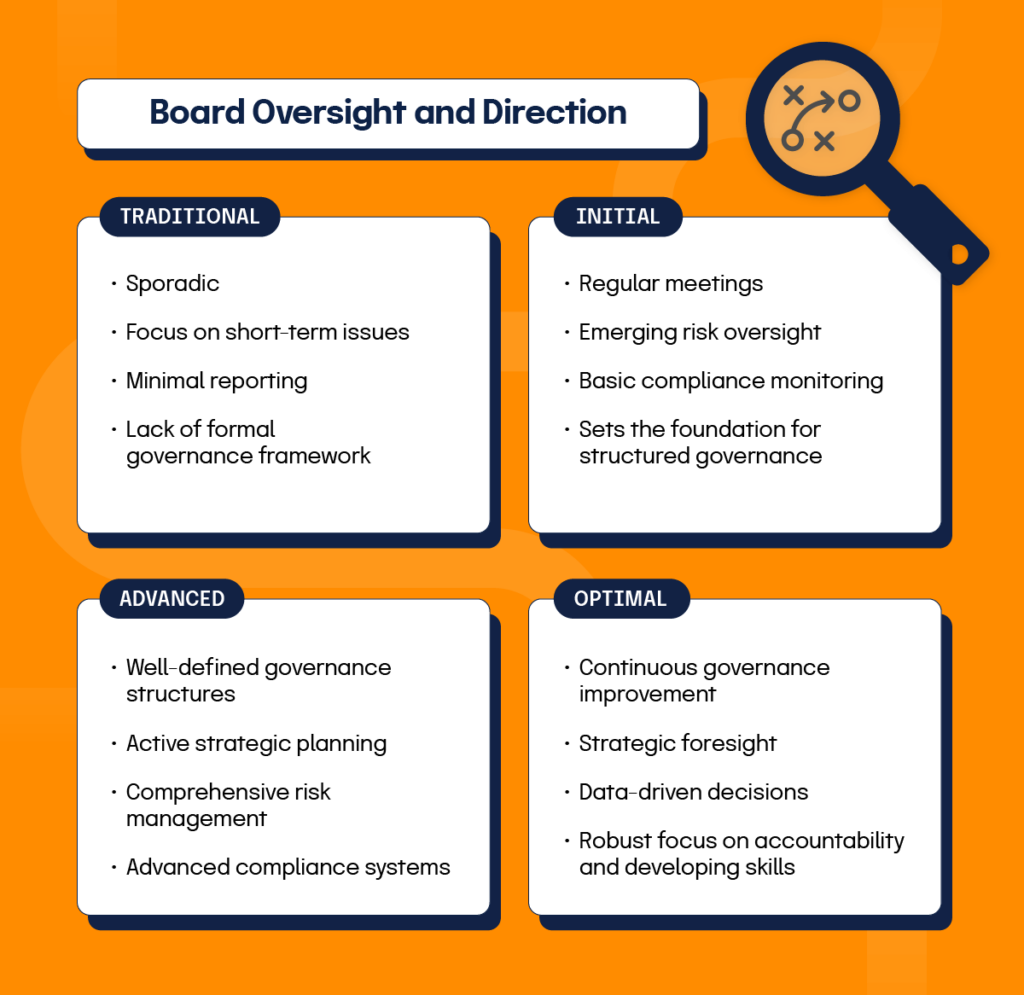
Risk
According to the model, Risk is a set of six distinct processes, though all of them work very closely together:
- Crisis management and response planning
- Integrating risk with strategy and decision-making
- Risk assessment and analysis
- Risk prioritization
- Risk mitigation planning
- Risk monitoring and reporting
Again, each of those processes can be at a different maturity level, from Traditional to Optimal. This might sound like a risk management framework, like ISO 3100 or NIST AI RMF, but it’s quite different; the GRC Maturity Model doesn’t have control requirements or definitions. Instead, it’s about what an organization does, which means you can use this alongside any risk management framework.

Wondering what the experts think of Hyperproof’s GRC Maturity Model?

Compliance
According to the model, Compliance is made up of six distinct processes:
- Attaining and maintaining external attestations and certifications
- Compliance with contractual requirements
- Compliance with legal requirements
- Managing relationships with regulatory bodies
- Monitoring and auditing
- Remediation of compliance issues
Again, each of those processes can be at a different maturity level, from Traditional to Optimal. Here’s an example of attaining and maintaining external attestations and certifications to give you an idea of how each maturity level is defined:
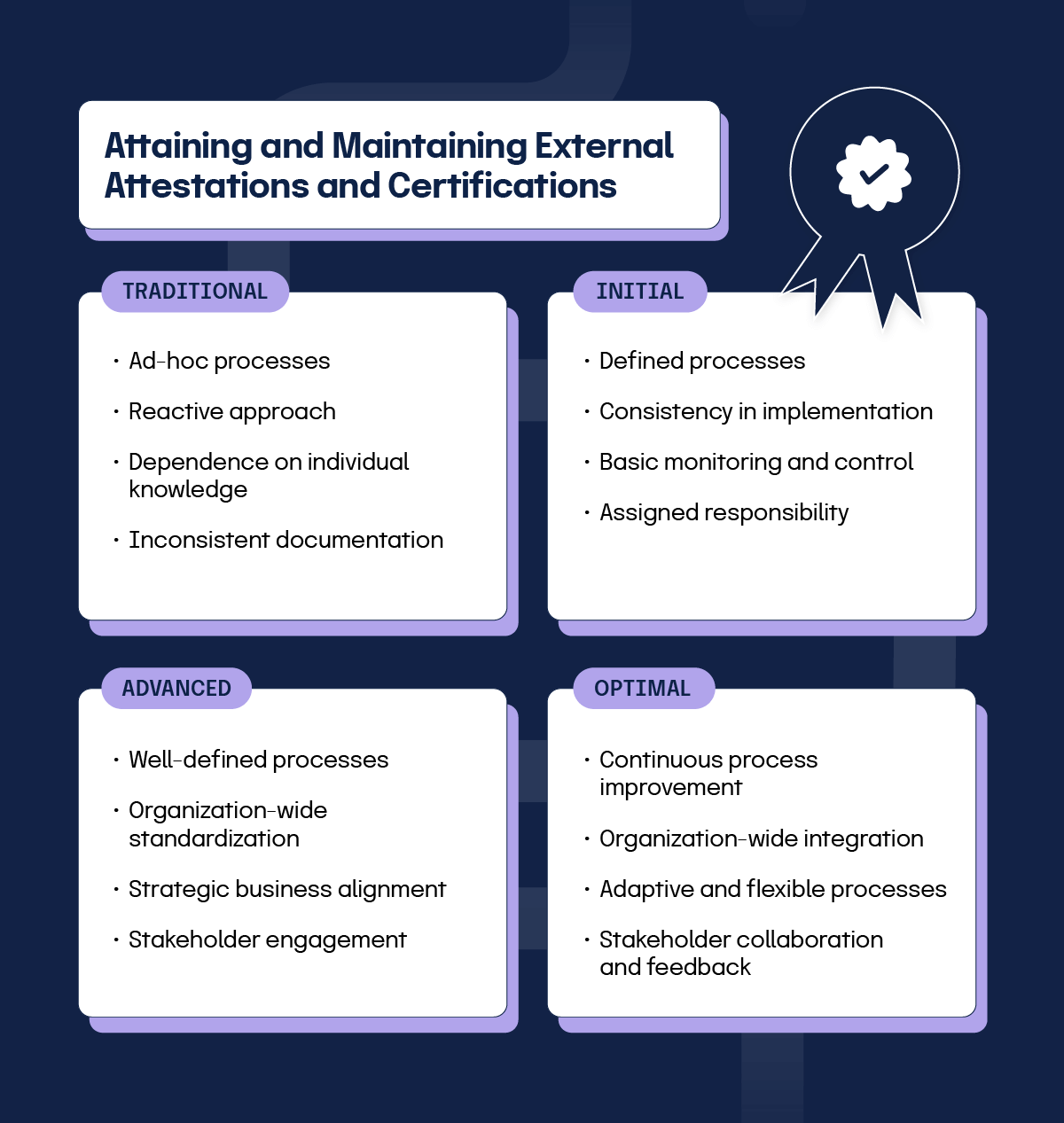
Compliance Operations (ComOps)
Compliance Operations (“ComOps”) is a section dedicated to integrating governance, risk, and compliance as efficiently as possible. ComOps serves as a foundational element that underpins modern GRC. ComOps represents efficiency, automation, and transparency so that different teams can effectively communicate. It is a deliberate attempt to improve transparency and reduce as many boundaries and data silos in organizations as feasible while still maintaining necessary separation for internal and external audit functions.
Organizations that adopt this foundational set of processes spend less time at manual and time-intensive operations and have far fewer errors than those that perpetuate a siloed approach. ComOps evolves from manual, inefficient processes to advanced, automated systems aligned with strategic objectives for optimal risk and compliance management. The GRC Maturity Model breaks ComOps into four maturity levels:
1. Traditional
Characterized by manual processes and basic digital tool adoption, leading to inefficiencies and potential errors
2. Initial
Integrated technology and standardized metrics, enhancing efficiency and transparency in compliance management
3. Advanced
Sophisticated analytics, automation, and a unified GRC framework, which allows for agile and informed decision-making
4. Optimal
Compliance processes are continuously improved, with predictive analytics and real-time monitoring integrated into strategic planning

Get a copy of the GRC Maturity Model
Now that you have an overview of how the GRC Maturity Model works and some examples of how to put it into practice, download the model for free and get started assessing your GRC maturity. We hope you can use it to build the business case for change.
See Hyperproof in Action
Related Resources
Ready to see
Hyperproof in action?






